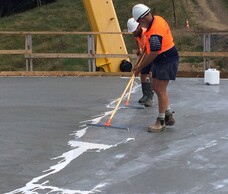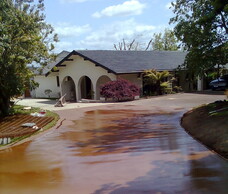Product
FRACURE
FRACURE is a synthetic hydrocarbon resin in solvent. When applied to newly poured concrete FRACURE quickly dries to form a film with low water vapour permeability. By reducing the rate of evaporation, the water necessary for hydration of cement is maintained in the concrete. During the early curing period, this allows the maximum development of compressive and tensile strength and results in more durable finished concrete with lower permeability and less shrinkage.
What's it used for?
FRACURE is applied to all exposed concrete elements of a structure subject to water loss due to evaporation. It creates a temporary coating on the surface that reduces moisture loss. FRACURE is ideally suited to applications where no coating remains after time due to weathering.
FRACURE can also be used to seal the surface of a newly poured concrete slab prior to using DISCRETE release agent to cast off the concrete.
What can it be applied to?
FRACURE is suitable for use on all concrete surfaces. All exposed elements of a structure subject to water loss due to evaporation will benefit from treatment. These include floor slabs, columns, beams, walls, precast panels etc.
Coverage: ............... 6 – 7m²/litre
Limitations
Not recommended for application to rough broomed concrete, otherwise breakdown and removal is difficult. If applied to interior surfaces not subject to normal weathering and traffic during construction, film breakdown will be delayed and may only breakdown due to the action of traffic. Any loose residue remaining before painting should be removed as far as possible by wire brushing or, for larger areas, use a mechanical floor scrubber fitted with a synthetic abrasive pad.
Product
FRACURE EMULSION
FRACURE EMULSION is a water-based emulsion concrete curing compound. When applied to newly poured concrete it dries fast to form a wear resistant film with low water vapour permeability. By reducing evaporation from the concrete surface, the water necessary for cement hydration is maintained. This allows the maximum development of compressive and tensile strength in the finished concrete and results in a more durable surface with lower permeability.
What's it used for?
FRACURE EMULSION is applied to all exposed concrete elements of a structure subject to water loss due to evaporation. It creates a wear resistant film with low water vapour permeability and good UV stability. FRACURE EMULSION is ideally suited to applications where the curing compound will help not only cure the concrete but help protect against dirt and discolouration during the construction phase.
What can it be applied to?
FRACURE EMULSION is suitable for use on all concrete surfaces. All exposed elements of a structure subject to water loss due to evaporation will benefit from treatment. These include floor slabs, columns, beams, walls, precast panels etc.
Coverage: ...............up to 7m²/litre
Limitations
FRACURE EMULSION creates a long-lasting, wear resistant film on the surface of the concrete. If subsequent coatings are to be applied that require bonding into the concrete, then consider FRACURE curing compound.
Subsequent coatings should not be applied over FRACURE EMULSION without checking with the manufacturer or supplier of the coating system for compatibility.
Product
FRACURE EMULSION 3109
FRACURE EMULSION 3109 is a water-based emulsion concrete curing compound that exceeds the moisture retention requirements of ASTM C309-97 when applied at 5m² per litre (conformance testing completed by BRANZ). When applied to newly poured concrete it dries fast to form a wear resistant film with low water vapour permeability. By reducing evaporation from the concrete surface, the water necessary for cement hydration is maintained. This allows the maximum development of compressive and tensile strength in the finished concrete and results in a more durable surface with lower permeability.
What's it used for?
FRACURE EMULSION 3109 is applied to all exposed concrete elements of a structure subject to water loss due to evaporation. It creates a wear resistant film with low water vapour permeability and good UV stability. FRACURE EMULSION 3109 is recommended for applications where the curing compound must meet ASTM C309-97 requirements.
What can it be applied to?
FRACURE EMULSION 3109 is suitable for use on all concrete surfaces. All exposed elements of a structure subject to water loss due to evaporation will benefit from treatment. These include floor slabs, columns, beams, walls, precast panels etc.
Coverage: ...............5 – 7m²/litre
Limitations
FRACURE EMULSION 3109 creates a long-lasting, wear resistant film on the surface of the concrete, especially when applied at 5m² per litre. FRACURE EMULSION 3109 should not be applied to concrete if it is required to be removed as removal will be difficult. If subsequent coatings are to be applied that require bonding into the concrete, then consider FRACURE curing compound.
Subsequent coatings should not be applied over FRACURE EMULSION 3109 without checking with the manufacturer or supplier of the coating system for compatibility.
Product
FRACURE WAX EMULSION
FRACURE WAX EMULSION is a water-based wax emulsion concrete curing compound which helps ensure that maximum strength and wear resistance of the concrete are achieved. When applied at 5 – 10m² per litre, it creates an impermeable seal which optimises water retention. FRACURE WAX EMULSION achieves the highest degree of protection from moisture loss compared to other curing compounds.
What's it used for?
FRACURE WAX EMULSION can be used on either interior or exterior, horizontal or vertical concrete applications where subsequent coatings or treatments will not be applied.
FRACURE WAX EMULSION exceeds ASTM-C-309-97 and NZS 3109 when applied at 5m² per litre. It is recommended for critical curing applications where the highest level of moisture retention is required.
A white pigmented version is also available for curing areas exposed to high levels of sunlight to help reflect heat away from the concrete surface.
What can it be applied to?
FRACURE WAX EMULSION can be used for:
Curing high performance floor toppings and dry shake hardeners (check compatibility with manufacturer of topping or hardener before application of FRACURE WAX EMULSION)
Areas that are not to be subsequently coated, such as pavements, hard-standing areas, etc
Curing where flammable solvents must be avoided
Applications with very high moisture retention requirements.
Coverage: 5 – 10m²/litre depending on requirements
Limitations
Do not apply FRACURE WAX EMULSION to any surface where subsequent coatings are to be applied (including paint, epoxies, membranes, coatings, etc that must bond onto or into the concrete). Do not use on brick, stone, masonry, etc. Once applied, it is unlikely that all traces of FRACURE WAX EMULSION will be able to be removed from the surface or pores of the concrete to which it is applied.
Product
ER-921
ER-921 is a surface-active agent used to reduce the water evaporation rate from the surface of newly laid concrete. It is designed to form a thin film to reduce rapid moisture loss from the concrete surface.
Supplied as a concentrate, diluted 1 part ER-921 to 9 parts clean water.
What's it used for?
Use ER-921 as an evaporation retarder for concrete flatwork surfaces when the evaporation rate exceeds the bleeding rate during finishing operations. ER-921 is especially recommended for use on concrete subjected to rapid drying conditions.
What can it be applied to?
ER-921 is recommended for use on all concrete surfaces except dry shake hardeners and toppings.
Coverage: .......up to 10m²/litre (when diluted)
Limitations
ER-921 is not to be used as a finishing aid for cementitious materials such as dry shake hardeners or toppings. ER-921 should not be worked into the concrete surface nor should it be used to re-temper concrete.
Not suitable for application onto vertical surfaces or where excessive run-off may occur.
Product
RETARDÉ E (STD and XTRA)
RETARDÉ E is a concrete surface retarder applied to the surface of freshly poured concrete and retards its set to a depth of 3 – 6mm while the underlying concrete hardens normally. The retarded concrete is then brushed or washed off leaving aggregate exposed but firmly embedded.
RETARDÉ E XTRA is for concrete strength above 25MPa.
What's it used for?
RETARDÉ E is used to produce decorative and non-slip exposed aggregate finishes to in-situ and precast concrete. Areas of use include paths, driveways, swimming pool surrounds etc.
What can it be applied to?
RETARDÉ E is applied to freshly poured concrete after all free water has disappeared from the concrete surface and before the concrete starts to set.
Coverage: ...............5m²/litre
Limitations
RETARDÉ E slows down the set of the surface concrete for up to 24 hours at normal temperature. Sun and shade on the treated concrete can vary the effectiveness of RETARDÉ E – avoid variations in temperature across the treated area. If necessary due to temperature and wind, remove retarded concrete sooner. If the surface is not removed during the retarded period the concrete will set and reach ultimate strength. Use RETARDÉ XTRA on concrete strengths above 25MPa and/or where high early age strengths are expected.
Correct application of an even film is essential. Avoid puddling.
Product
RETARDÉ M
RETARDÉ M is a solvent based paint-like liquid which, when applied to formwork or moulds, prevents concrete poured against it from setting for up to 72 hours. This allows the retarded concrete to be removed by hose after the formwork has been stripped, resulting in an exposed aggregate finish.
What's it used for?
RETARDÉ M is used to create a mechanical key on a concrete surface which is to have more concrete poured against it. An example of this is where RETARDÉ M is painted on stop ends which confine individual pours of a floor slab. When the stop ends are removed and the retarded concrete is washed off, the resultant exposed aggregate finish makes an excellent key for the next pour.
What can it be applied to?
RETARDÉ M can be applied to timber, steel or other types of moulds and formwork that are resistant to a solvent-based material. Absorbent timber formwork should be first sealed with FORMSEAL.
Coverage: ...............5 – 6m²/litre
Limitations
RETARDÉ M is resistant to light rain but should be protected from heavy rain and direct sunlight. Multiple coats of RETARDÉ M increase the dry film thickness and depth of retardation. If unusual aggregate sizes are being used it is advisable to make preliminary tests to determine the correct depth of retardation.
Accelerating admixtures, steam curing and hot weather all reduce the effectiveness of RETARDÉ M.
Product
ETCHING FLUID
ETCHING FLUID is a water based concrete surface retarder which when applied to formwork, prevents concrete poured against it from setting to a depth of 5-10mm, for up to 48 hours. This allows the retarded concrete to be removed by hose after the forms have been stripped, resulting in an exposed aggregate finish.
What's it used for?
ETCHING FLUID is used to create a mechanical key on a concrete surface which is to have more concrete poured against it. An example of this is where ETCHING FLUID is painted on stop ends which confine individual pours of a floor slab. When the stop ends are removed and the retarded concrete is washed off, the resultant exposed aggregate finish makes an excellent key for the next pour.
What can it be applied to?
ETCHING FLUID can be applied to timber, steel or other types of moulds and formwork. Absorbent timber formwork should be first sealed with FORMSEAL.
Coverage: .....5 – 6m²/litre (surface dependent)
Limitations
ETGHING FLUID will retard to a depth of up to 10mm depending on concrete strength. Decorative concrete mix designs should be tested for appearance and retarded depth. ETCHING FLUID has no release value so that forms should get normal treatment with DISCRETE before application. This will prevent any build up on the stripped forms sticking after the retarded concrete has eventually set.
Normal concrete placed at normal temperatures should be removed within 48 hours. High strength concrete or concrete placed at higher temperatures will not be retarded for as long and consequently should have forms stripped and retarded concrete removed within 24 hours or sooner.
Product
ETCHING GEL
ETCHING GEL is a water based gel for use as a concrete set retarder on vertical and horizontal formwork. It prevents concrete setting (curing) for up to 48 hours and to a retarded depth of up to 10mm depending on concrete strength. This allows the retarded concrete to be removed by hose and/or brush after the forms have been stripped, resulting in an exposed aggregate finish.
What's it used for?
ETCHING GEL is used to create a mechanical key on a concrete surface which is to have more concrete poured against it. An example of this is where ETCHING GEL is painted on stop ends which confine individual pours of a floor slab. When the stop ends are removed and the retarded concrete is washed off, the resultant exposed aggregate finish makes an excellent key for the next pour.
What can it be applied to?
ETCHING GEL can be applied to timber, steel or other types of moulds and formwork. Absorbent timber formwork should be first sealed with FORMSEAL.
Coverage: .....5 – 6m²/litre (surface dependent)
Limitations
ETGHING GEL will retard to a depth of up to 10mm depending on concrete strength. Decorative concrete mix designs should be tested for appearance and retarded depth. ETCHING GEL has no release value so that forms should get normal treatment with DISCRETE before application. This will prevent any build up on the stripped forms sticking after the retarded concrete has eventually set.
Normal concrete placed at normal temperatures should be removed within 48 hours. High strength concrete or concrete placed at higher temperatures will not be retarded for as long and consequently should have forms stripped and retarded concrete removed within 24 hours or sooner.
Concrete Etching & Removal
To etch or remove existing concrete or concrete splashes
Product
DECEMENT
DECEMENT is a mild water based concrete splash and efflorescence remover.
DECEMENT may also be used to remove efflorescence from a substrate.
What's it used for?
DECEMENT is used as an alternative to strong acid solutions commonly employed to remove cement splashes from a range of surfaces. It can also be used to remove efflorescence from substrates.
What can it be applied to?
DECEMENT may be applied to a wide range of substrates including concrete truck mixer bowls, concrete tools and equipment.
DECEMENT may also be applied to substrates for the removal of efflorescence (refer Limitations).
Coverage: ...............Variable - surface dependent
Limitations
Before using DECEMENT on decorative or delicate surfaces such as aluminium, painted, powder coated, etc test for suitability by applying a small amount of DECEMENT to an inconspicuous area. Wash off and check no undesirable side-effects of the application. Surfaces cleaned of efflorescence must be protected against further potential efflorescence using products such as AQUELLUX S and PROTECTA-COAT (refer product data sheets for details). DECEMENT is used in the process of removal of efflorescence and will not prevent recurrence.
Product
MISTIC ACID
MISTIC ACID is a concrete etching and removal acid which consists of Hydrochloric acid modified with wetting and foaming agents to allow even coverage of vertical or horizontal surfaces. It is not subject to NZ Health and Safety "Restricted to use in a workplace" Legislation.
MISTIC ACID has a much lower toxicity than full strength hydrochloric acid, but is just as effective on concrete.
What's it used for?
MISTIC ACID is used for etching of concrete surfaces to give a mechanical key prior to application of surface coatings, or to make the surface non-slip. It may also be used for the removal of cement splashes from decorative or exposed aggregate panels and other surfaces.
MISTIC ACID will work on concrete substrates more effectively than ordinary hydrochloric acid as it is able to "wet" the substrate and react more efficiently.
MISTIC ACID can be used to remove iron oxide (rust) from steel.
What can it be applied to?
MISTIC ACID is applied to concrete, steel and other surfaces requiring etching or cleaning. MISTIC ACID will react with iron, steel, aluminium and zinc so care must be taken when applying to these substrates.
Coverage: .....up to 2m²/litre (dilution dependent)
Limitations
MISTIC ACID may be applied as supplied or diluted with clean water depending upon the application. Dilution will slow the reaction proportionally. Multiple applications may be required to etch concrete or remove concrete splashes.
MISTIC ACID should not be used on marble or galvanized steel or decorative surfaces.
MISTIC ACID will not remove acrylic sealers or other coatings from the surface of concrete.
Information presented on this website must be read in conjunction with the latest technical datasheet, product label and any other application data.
Click here to download technical data







